Discover, Learn, immerse, Connect
Cave Temples of Mumbai - A Slice of the City’s Past
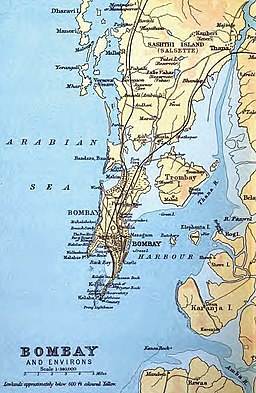
Map of Bombay, 1893, showing the Islands of Salsette and Elephanta
Source - Wikimedia Commons
The city of Mumbai is home to ancient cave temples dedicated to Buddhist and Hindu faiths. These caves stand silently amidst the hustle and bustle of some of the busiest suburbs of the metropolis which lie on the island of Salsette (Shatshashthi) and on the neighbouring island of Elephanta, which is 11 km offshore. Though the total number of caves are nearly 130, the most important ones are the Hindu caves of Jogeshwari, Mandapeshwar and Elephanta, and the three Buddhist caves of Mahakali, Kanheri and Magathane. Together they tell the story of the rise and progress of Buddhist and Hindu religions and show clearly how the Hinayana sect was superseded by the Mahayana and how Hinduism adapted caves to their modes of worship.
The fact that many of these caves were excavated on Salsette was not a mere coincidence. The island is situated near the flourishing ports of Sopara, Kalyan and Chemula. This area had a wealthy local population which must have funded the excavation and upkeep of these temples and monasteries. Also, the island has hills, with spurs running west towards the sea. These hills are made up of horizontal trap-rocks which are uniform in their composition and have alternating strata of hard and soft rocks that are well suited for excavating and sculpting.
The building of these caves was started as early as the 1st Century B.C. and continued till the 8th Century A.D. The area was ruled by different Hindu rulers and the caves were active places of worship till the overthrow of the Devgiri Yadavs by Ala-ud-din Khilji (1295-1316) at the close of the 13th century. The area remained under occupation of the Muslim kings of Ahmedabad and passed under Portuguese occupation in 1534. It was then that these caves were visited and chronicled by European travellers such as D’Orta, Linschoten, Fryer, Gemelli Careri, Anquetil, Du Perron, and others. This was aided by the reason of their easy access from Bombay. (The name of Bombay was changed to Mumbai in 1995. The name Bombay has been used in the article to refer to the colonial city, wherever necessary.)
Bombay was taken over by the British East India Company in 1668 and English explorers started visiting the caves. The English Governor of Bombay, Charles Boone (1715-1722) hired an Indian artist to make drawings of the Buddhist temples in Salsette, which he sent to England. Boone as well as two other explorers, Captain Pyke and Richard Bourchier, the Governor of Bombay (1750-1760), contributed rich accounts of these caves. Henry Salt’s description of the caves on the island of Salsette were published in 1819 which contained drawings made by him and Major Atkins of the Bombay establishment.
In 1843 James Fergusson, an elected member of the Royal Asiatic Society presented a paper to the Society on the Rock-Cut Temples of India. This led the Society to send a Memorial to the Court of Directors of the East India Company to make efforts for the documentation and preservation of the caves. The Directors accordingly instructed the Company to undertake the measurement and drawing of the antiquities. In 1847 Dr. Bird published his research on the caves. The interest aroused by these led to the formation of a Cave Commission in Bombay in 1848. The Commission consisted of Dr. J. Wilson, Dr. Stevenson, C. J. Erskine, Capt. Lynch, Dr. J. Harkness, Vinayak Gangadhar Shastri, and Dr. H. J. Carter. It worked till 1861 and received accounts of the antiquities and got the mud cleared from the Elephanta Caves.Dr. W. West and his brother Mr. Arthur A. West made a large collection of notes and drawings from the Rock-Temples of the Bombay Presidency. In July 1851, Lieutenant Brett was employed to take facsimiles of the inscriptions from the caves, under the direction of a despatch from the Directors.
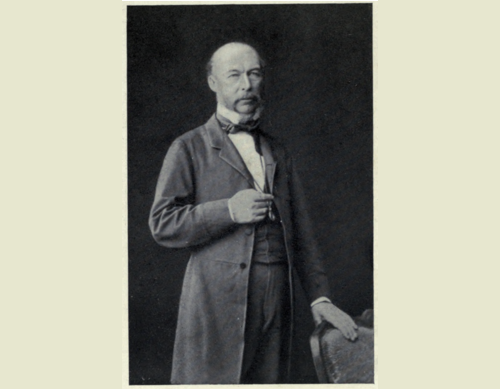
James Fergusson
Source: Wikimedia Commons
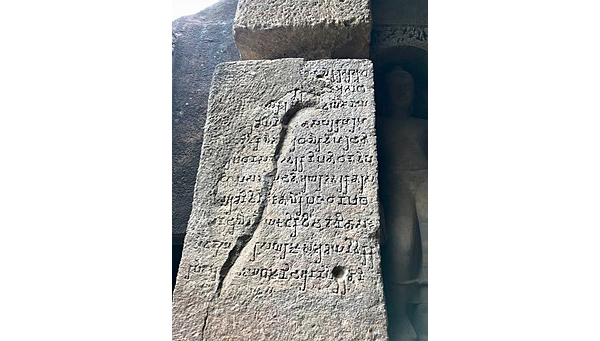
An Inscription in the Brahmi Script from the Kanheri Caves
Source: Wikimedia Commons
In 1871 the Secretary of State for India in Council proposed a survey of the architectural antiquities of Western India. Accordingly, archaeologist James Burgess (Head of the Archaeological Survey of Western India, 1873, of South India, 1881, and Director General, Archaeological Survey of India (1886-89)), carried out extensive surveys in western India between 1871 and 1885. He presented his findings and drawings in three reports. In 1871 the Secretary of State for India sanctioned a proposal for the writing of a general history of Cave Architecture in India by James Fergusson and James Burgess. With the publication of their seminal work titled ‘Cave Temples of India’ in 1880, a milestone was reached in the study of these caves. Efforts continued in the direction of further documentation and translation of inscriptions and interpretation of numismatic finds. Later the caves were described in detail in the Bombay Gazetteer compiled by J. M. Campbell. This description was mostly drawn from Henry Salt’s narrative, to which Campbell added his own eye-witness account.
Elephanta Caves
The most famous of these caves are the Elephanta caves, which were declared a World Heritage monument under UNESCO.These are situated on the Gharapuri island, where the construction was started by the Hinayana Buddhists in the 2nd century B.C. as is evident from the remains of a stupa, monastery and water cisterns but a complete lack of statues of Buddha.
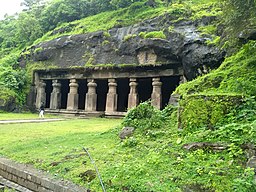
Elephanta Caves
Source: Wikimedia Commons
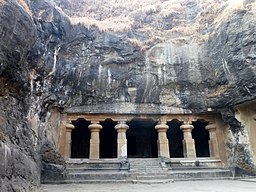
Elephanta Caves
Source: Wikimedia Commons
The next phase (5th to 8th centuries A.D.) saw the making of caves dedicated to the Hindu god Shiva, who is represented here as the three-headed God, Trimurti Sadashiva, Ardhnarishwar, Nataraj, Yogishwara and in various other panels depicting mythological stories associated with the Lord.
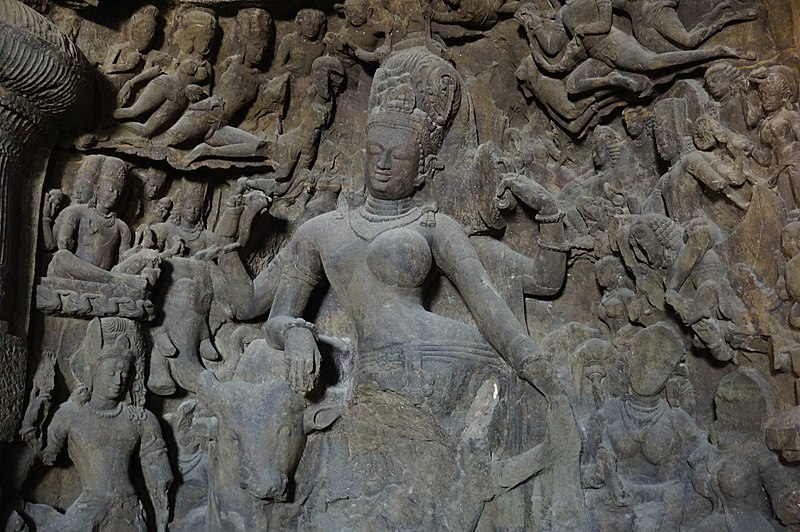
Ardhanarishwar, Elephanta Caves
Source: Wikimedia Commons
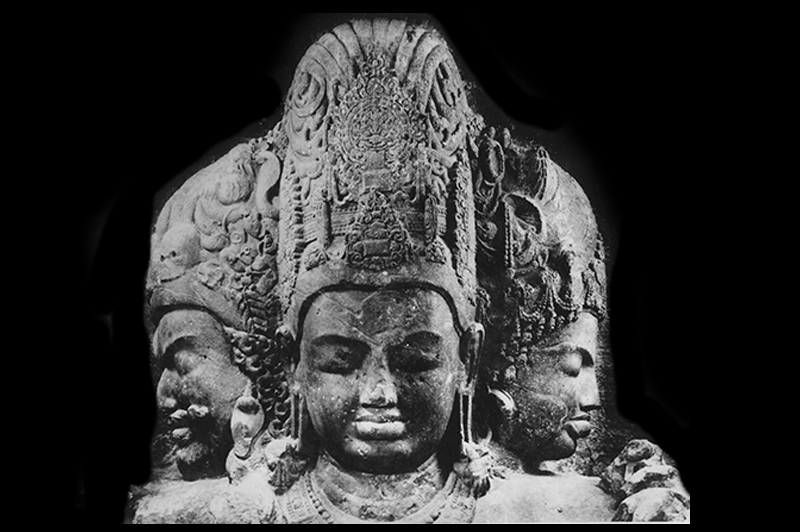
Elephanta. Trimurti
Source: Archaeological Survey of India
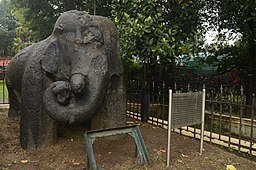
Stone Elephant from Gharapuri Island, now displayed in JijamataUdyan, Mumbai.
Source: Wikimedia Commons
Cave 1 contains a Linga shrine, complete with a circumambulation path. The Portuguese explorer, D’Orta’s account is one of the earliest and the most comprehensive descriptions of the caves. When the Portuguese had arrived they had seen a stone statue of an elephant near the landing-place, which was 13 ft. 2 inches long and 7 ft. and 4 inches high, and hence named the island as Elephanta. The British tried to move the statue to England in 1864, but due to the breakdown of the crane the statue fell and was shattered. It was brought to the Victoria Garden (presently the Veer Jijamata Bhosale Udyan), in Mumbai, where it was put together by the curator of the Victoria and Albert Museum (now Bhau Daji Lad Museum), Sir George Birdwood, and that is where it is presently displayed.
A stone inscription found near the caves was sent to Portugal by the Portuguese Viceroy Dom Joao de Castro as he could not get it translated. Even the King could not get it deciphered and it was later said to be lost. This could have perhaps given information about the date and name of the builders of these caves.
Kanheri Caves
Themost extensive caves construction on the mainland can be seen in the Kanheri caves, which presently lie inside the Sanjay Gandhi National Park in the suburb of Borivali. These were built by Buddhist monks starting from the 1st century B.C. till the 10th century A.D. This long period was witness to the Hinayana and the Mahayana phases of Buddhism. Thus the earlier caves are very simple and unadorned, while the later ones have statues and intricate reliefs of Buddha and the Bodhisattvas. The caves house Chaityas (prayer halls), a large number of Viharas (living areas) and other utilitarian structures which point to the fact that this was a large monastery and a centre of learning.
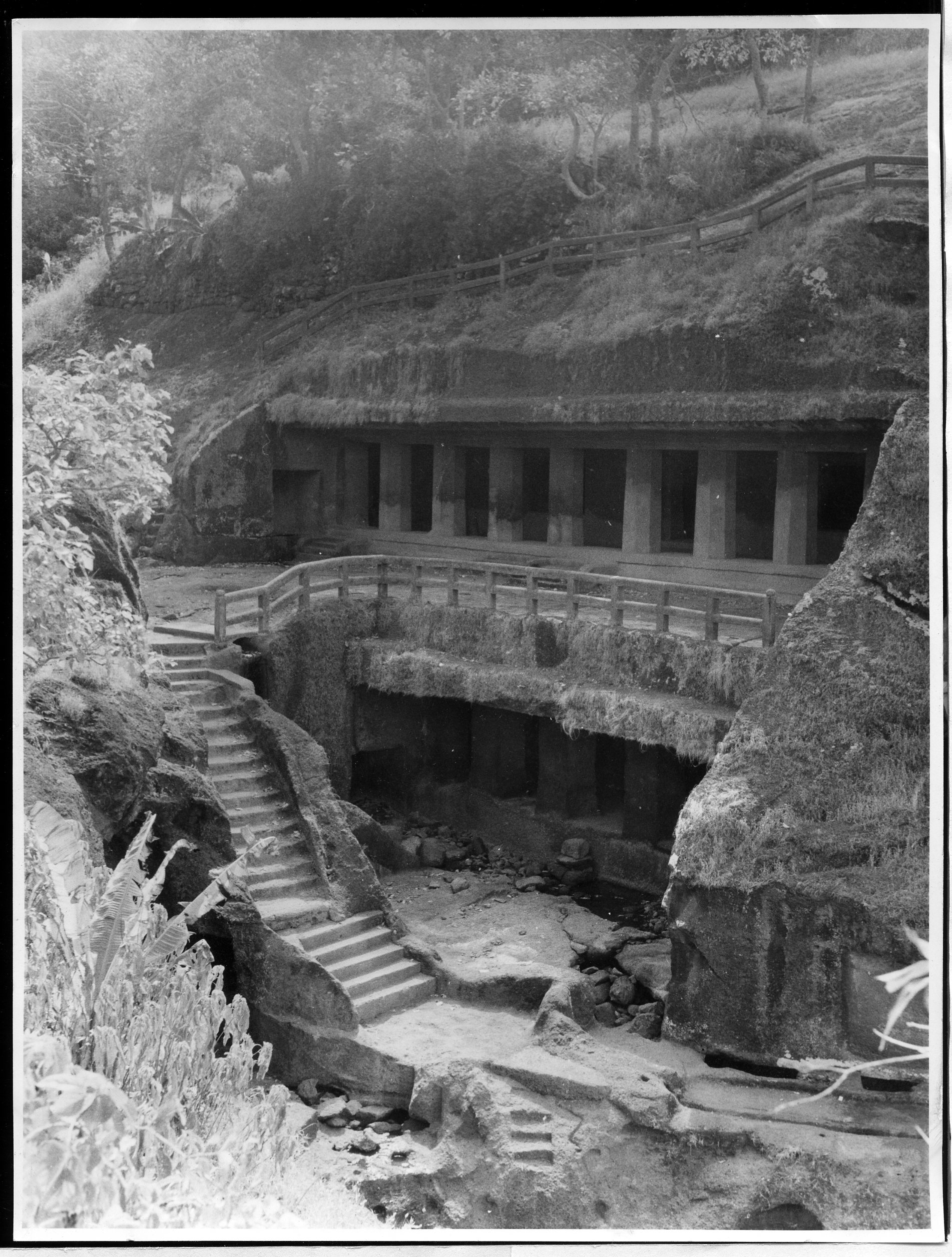
Kanheri cave 5 to 8
Source: Archaeological Survey of India
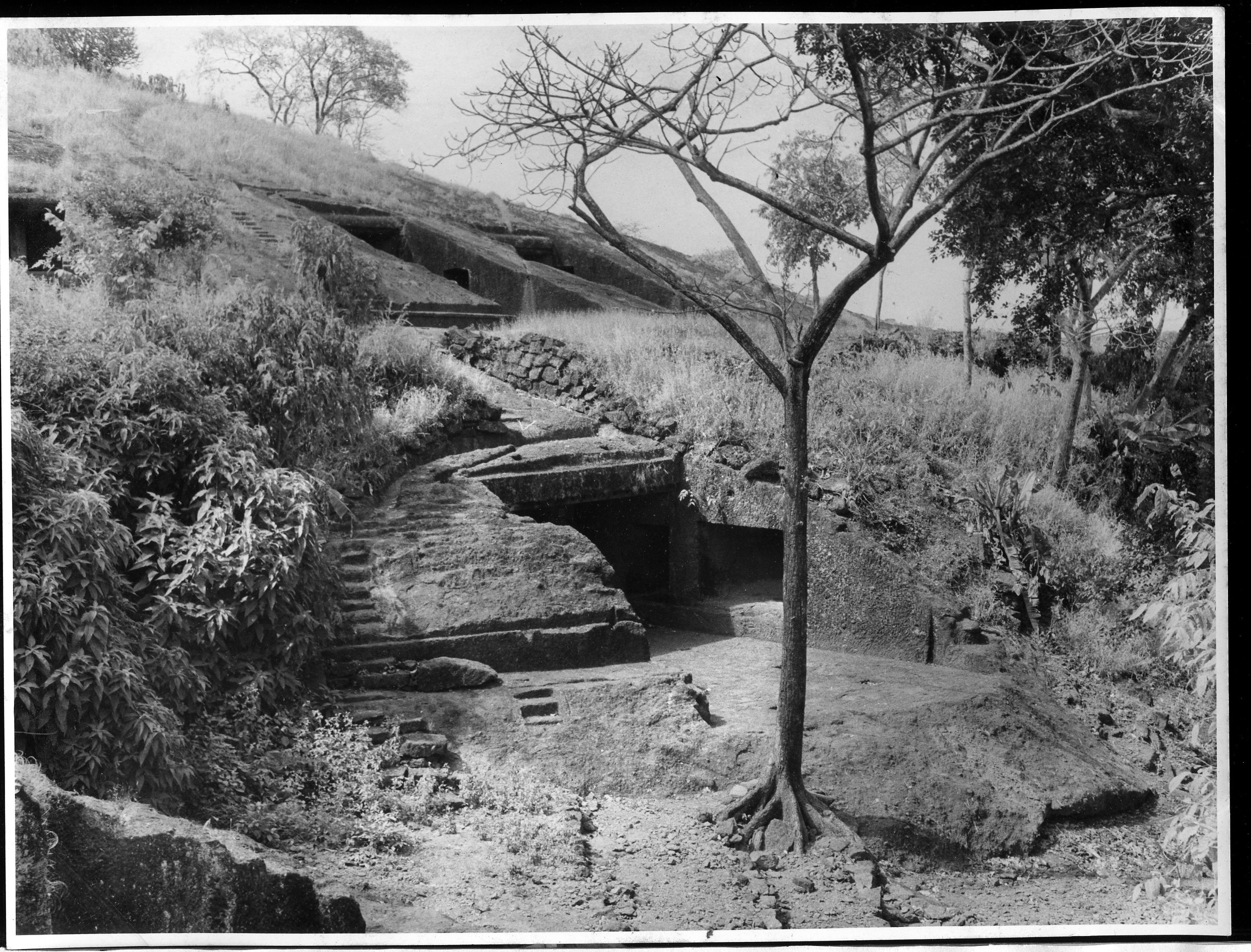
Kanheri cave 65
Source: Archaeological Survey of India
The great Chaitya hall housed in cave No. 3 has the unique distinction of having a stone railing enclosing the outer courtyard. Inside, the hall is 86.5 ft. long, 39 ft. 10 inches broad, with a total of 34 pillars which divide the hall into the nave and the two side aisles. It houses a plain stupa which has a diameter of 16 ft.
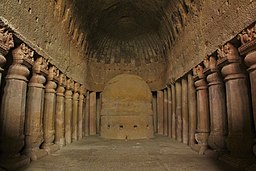
The Great Chaitya Hall at Kanheri
Source: Wikimedia Commons

The Great Chaitya at Kanheri
Source: Wikimedia Commons
Kanheri caves have yielded more than 100 inscriptions. The majority of these are in the Brahmi script, in the Prakrit language. While their content is dedicatoryin nature, yet information about the Indian culture and religious practices can be gleamed from them.
Jogeshwari Caves
These are a set of large Hindu caves built in the latter half of the 8th Century B.C., which stands in grandeur and ornamentation in the third place only after Ellora and Elephanta caves.
According to Dr. Burgess, its architecture is such that there are no traces of it being a Buddhist monastery. Rather it appears to be the predecessor of the structural temples that came up in the 11th -12th Century A.D. in places such as Ambarnath near Kalyan (1060), and in Pattan Somnath in south Kathiawar (1198). The main hall, which is square-shaped as opposed to the star shaped ones at Elephanta and Ellora, houses the linga shrine in the middle. The shrine is separated from the aisles by equally spaced pillars.The cave has sculptures of Lord Shiva seated like an ascetic, and in dancing poses.
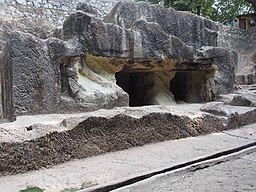
Jogeshwari Caves
Source: Wikimedia Commons
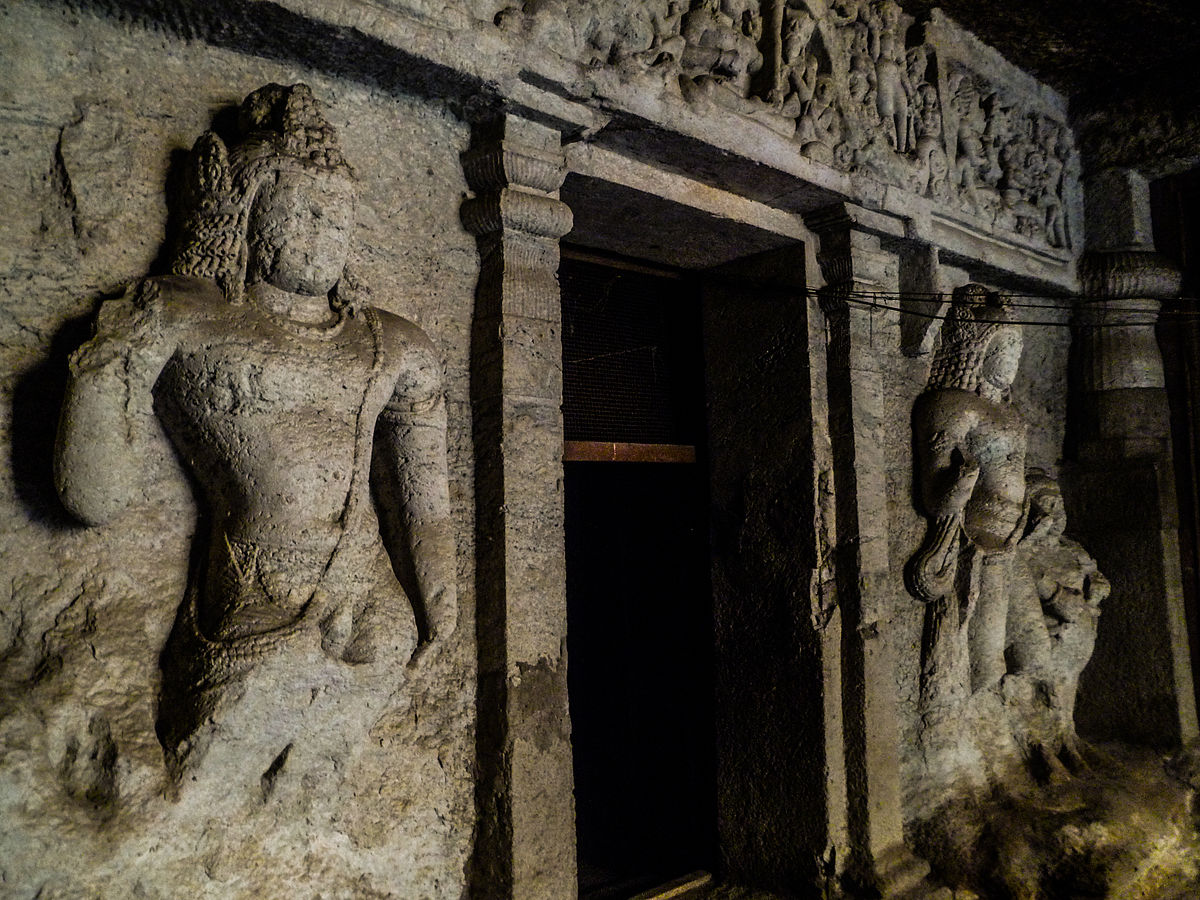
Sculpture inside Jogeshwari Caves
Source: Wikimedia Commons
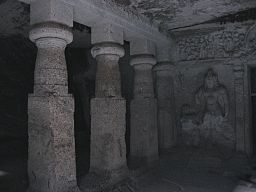
Hall inside Jogeshwari Caves
Source: Wikimedia Commons
Mahakali (Kondivte) Caves
Located in the modern suburb of Andheri, the Mahakali or the Kondivte caves are Buddhist caves built between the second and sixth centuries. They are small, many of them little more than cells, and are in a much-ruined state mainly due to the flawed nature of the rock. There are two sets of caves on the west and east side of a hill. The western row consists of four small caves and the eastern has 12 caves. These consist of prayer halls, dwellings, water cisterns, and courtyards, with the sculptures of Buddha and his attendants adorning the walls. The prayer hall has a stupa in the back wall.
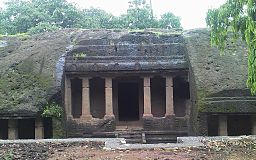
Mahakali Caves
Source: Wikimedia Commons
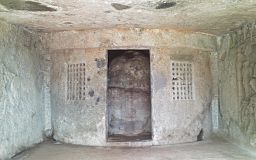
The Stupa in the Mahakali Caves
Source: Wikimedia Commons
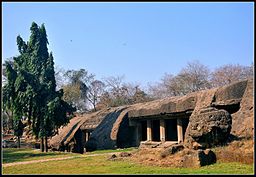
Mahakali Caves
Source: Wikimedia Commons
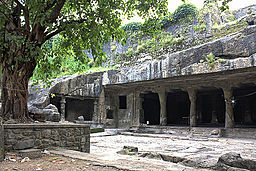
Mandapeshwar Caves
Source: Wikimedia Commons
Mandapeshvar Cave
Also called Montpezier or Monpacer by the Portuguese, the Mandapeshwar cave is located in the suburb of Borivali. This large Brahmanical cave was dedicated to Lord Shiva, but it was converted into a Catholic church by the Franciscan fathers in 1556. They built a wall in front of the cave and screened off or covered with plaster most of the Shaiva sculpture. The church was dedicated to Nostra Senhora da Conceicao. A large college was also established here by the Franciscan missionary, P. Antonio de Porto, by order of the Infant Dom John III the King of Portugal. It was meant for the education of the children of all those locals who had converted to Christianity. The King also transferred the revenues, which belonged to the Hindu saints to the Church.
The main hall is 51 ft. by 21 ft. and has 4 richly ornamented pillars in front. At the two ends are two smaller rooms. The one to the left has a wall, behind which lie large sculptures of dancing Shiva, Vishnu on his mount, Garud, a three-headed Brahma, Ganapati, and Indra on his elephant, all surrounded by their attendants, and worshippers. In the middle of the back wall is the small shrine room. While the cave is cut into a low rock, the monastic building stands on top of it.
Magathane (Poinsar) Caves
Situated in the modern suburb of Borivali, these are Buddhist caves which consist of a prayer hall and a monastery. In the back of the hall of the principal cave is a large figure of Buddha, squatted in the Gyana Mudra, and above his shoulders are other smaller images in the same pose. The walls of this shrine are sculpted with numerous figures of Buddha on the Lotus Throne upheld by Naga figures. The arched entrance has an ornamental frieze between two makara heads. Henry Salt has reported of the presence of cells beyond the main cave. On the walls of one of these is a large figure of seated Buddha, with two attending figures carved in high relief . Although the caves are in a dilapidated condition, the remains point to an origin of the sixth or seventh century A.D.
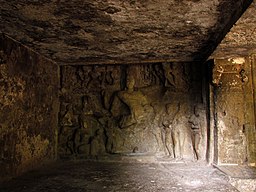
Sculpture inMandapeshwar Caves
Source: Wikimedia Commons
 Government of India
Government of India


